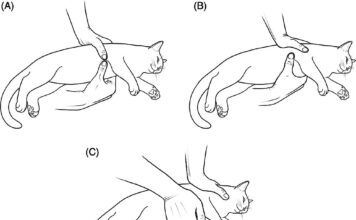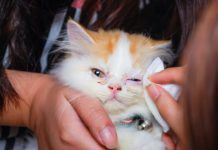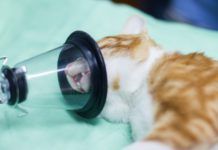Coping With Feline Herpesvirus
Most cats are likely to contract an upper respiratory disease at some point during their lives. Although a wide range of viral and bacterial agents may be responsible for these common disorders, perhaps the most frequently diagnosed is infection with the feline herpesvirus (FHV).
Taking Care of a Diabetic Cat
Diabetes mellitus is a frequently diagnosed disease of the feline pancreas, a relatively small, thin organ nestled in the front portion of a cats abdomen.
When Your Cat Vomits (A Lot)
Digestive system disorders are among the most frequently observed health problems in cats. Many of these disorders may be directly associated with organs such as the liver, pancreas and gall bladder, all of which play a crucial role in the digestive process. Many others, however, may arise in the alimentary canal, the long tube leading from a cats mouth and extending the full length of the animals body. A signal that something has gone wrong somewhere within this passageway often takes the form of a process scientifically termed emesis - but most commonly referred to as vomiting.
Dear Doctor: A Chronic Weeping Eye
I have a cat that has a problem with a weeping eye (at the nose), a condition she has had for several years.
Curbing Pet Overpopulation
Theres an abundance of kittens right now. Go visit the local shelter and have a look. Or peruse Craigslist or other Internet sites and see how many unwanted litters are out there.
The Ability to Detect a Single Cancer Cell During Surgery
When removing a malignant tumor, a surgeon cant see a single cancer cell left behind with the naked eye - or even 10,000 cancer cells. Thats a microscopic amount, which is why excised tumors currently get sent to pathologists. They can look at a few small sections of an excised tumor under the microscope and get an idea of whether the cancer was removed in its entirety. But what if a method was developed that allowed cancer surgeons to see right in the operating room, before the patient was closed back up, whether any cancer cells remained?
The Other Opioid Crisis
While opioids are destroying peoples lives and the lives of their family members throughout all strata of society - rich, poor, urban, suburban, rural - they are also in short supply in hospitals around the country. This is true both for hospitals that serve people and those that serve their pets. Reports are coming in that in some hospitals, elective surgeries for people - gall bladder removal, hernia repair - are being postponed, while some people in post-operative recovery are said to be receiving less potent medication than they need.
An Update on Anesthesia
The risk of death for cats under anesthesia used to be one to two deaths in 100 patients, says Lois Wetmore, DVM, an assistant professor of anesthesia and pain management at the Tufts Cummings School of Veterinary Medicine. Now were down to about one death in 1,000, Dr. Wetmore says. Were headed in the right direction.
Dear Doctor: Falls and concussions
We live in a rural community, and have a couple of indoor-only cats, in addition to a few barn cats out back (we tried to bring them inside when they were kittens, but they were very unhappy with that lifestyle).
Dear Doctor: What does bunting mean?
My son recently adopted an adult cat from a shelter, and I notice that Tigger likes to rub his cheeks repeatedly on the legs of the furniture. In fact, he started to do the same thing to my face when I was petting him on the couch!
Dear Doctor: Issue of a Chronic Weeping Eye
I have a cat that has a problem with a weeping eye (at the nose), a condition she has had for several years. Now, the iris is gradually turning orange, starting at the nose, and the eye is starting to squint slightly. This seems to be getting worse.
The Real Danger of FLUTD
It is very common in veterinary practices - especially feline-only practices - for clients to present a cat with the problem of straining to urinate. Typically, the straining is often accompanied by other signs, such as urinating more frequently, urinating very small amounts, and doing it in inappropriate places, i.e. places other than the litter box.













